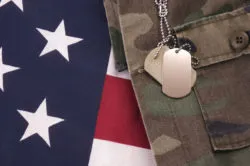 Servicemembers Group Life Insurance (SGLI) is provided on an automatic-enrollment basis upon enlistment in any of the four branches of the U.S. military, according to military.com. The premiums for this coverage are deducted from the serviceperson’s salary each pay period.
Servicemembers Group Life Insurance (SGLI) is provided on an automatic-enrollment basis upon enlistment in any of the four branches of the U.S. military, according to military.com. The premiums for this coverage are deducted from the serviceperson’s salary each pay period.
An additional flat rate of $1 per month is the cost for traumatic injury protection or Traumatic Servicemembers Group Life Insurance (TSGLI) as indicated by the U.S. Department of Veteran Affairs. While a member of the military is free to shop around and find a life insurance policy which might better suit their needs on the open market, there are pluses to having this extra tier of protection.
Who Is Eligible for TSGI?
If you have been automatically enrolled in and are covered by the Servicemembers Group Life Insurance plan, the enrollment in TSGI is equally as automatic unless specifically rejected by the enlisted person. The benefits are applicable not only to full-time military, but also to members of the National Guard, reservists, those engaging in funeral honors duty or one-day muster duty.
What Are the Stipulations for Benefit Payments Under TSGLI?
Like all insurance policies, there are parameters that stipulate when benefits are payable or not payable to an injured military serviceperson. Chief among those rules is that the injured party must be insured by SGLI when the traumatic injury happens. Secondly, the associated injury must have happened before midnight on the last day of service within the chosen branch of military service and result in a loss of physical function outlined by the Veteran’s Affairs.
According to a separate list of TSGLI standards published by the Veteran’s Affairs website, a sample of losses resulting from traumatic injuries include total loss of sight in one or both eyes or total loss of hearing in one or both ears. Additionally, quadriplegia, paraplegia, hemiplegia, and uniplegia as well as total loss of speech are mentioned as qualifiers. Finally, various necessary amputation situations, burns, traumatic brain injuries, and comatose states are indicated.
What If the Injury Caused the Loss After a Period of Time Has Lapsed?
In order to be considered connected to the covered injury which is alleged to have caused the loss, the loss must follow within two years or 730 days of the trauma. The exception to this rule is a retroactive benefit signed into law in 2010 by President Obama which affects service people injured in the time period between Oct. 7, 2001 and Nov. 30, 2005. The intention was to expand benefits to those military service people that fought in the Afghanistan and Iraqi wars, but you don’t have to have been injured while serving geographically in these locations to qualify. You could have been injured elsewhere and still be able to tap into this expansion of coverage. As an additional note, those service people injured during this time window that had opted out of SGLI would still qualify for traumatic injury benefits.
Get Help Filing Your TSGLI Claim
If you’re a servicemember who was injured while on active duty, in the National Guard or on reserve, you may qualify for benefits through the Traumatic Protection Program through the Servicemembers Group Life Insurance.
Fill out the form on this page for more information.
ATTORNEY ADVERTISING
Top Class Actions is a Proud Member of the American Bar Association
LEGAL INFORMATION IS NOT LEGAL ADVICE
Top Class Actions Legal Statement
©2008 – 2025 Top Class Actions® LLC
Various Trademarks held by their respective owners
This website is not intended for viewing or usage by European Union citizens.
Get Help – It’s Free
Get Help Filing Your TSGLI Claim
If you qualify, an attorney will contact you to discuss the details of your potential case at no charge to you.
PLEASE NOTE: If you want to participate in this investigation, it is imperative that you reply to the law firm if they call or email you. Failing to do so may result in you not getting signed up as a client or getting you dropped as a client.
Oops! We could not locate your form.












